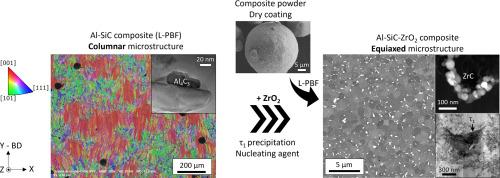Effect of a Zr source addition on the microstructure of Al-SiC composites elaborated by the Laser Powder Bed Fusion (L-PBF) process
IF 5.5
2区 材料科学
Q1 MATERIALS SCIENCE, CHARACTERIZATION & TESTING
引用次数: 0
Abstract
The present work focuses on the effect of the addition of a zirconium source on the microstructure of Al-SiC composites produced by Laser Powder Bed Fusion (L-PBF). More specifically, the aim is to address the issue of the SiC decomposition into the water-soluble aluminum carbide Al4C3 in Al-SiC composites produced by L-PBF, with the objective of limiting its formation by adding another element to the system. To this end, AlSi7Mg0.6-SiC-ZrO2 composite powders are successfully prepared and printed in a standard L-PBF equipment. The resulting parts are then thoroughly characterized, in order to understand the physico-chemical mechanisms involved during the L-PBF process. The results show a decrease in the Al4C3 amount by ZrC formation. Another important result is that bulk composites exhibit a fully equiaxed microstructure attributed to the τ1 (Al,Si)3Zr ternary phase, with all the characteristics of a good nucleating agent for aluminum phase. To support these microstructure experimental results, a first version of a quaternary Al-Zr-Si-C thermodynamic database was developed using the Calphad method. These calculations enable to establish a solidification path providing information on the phases that may form after heat treatment of L-PBF materials.

添加 Zr 源对激光粉末床熔融 (L-PBF) 工艺制备的 Al-SiC 复合材料微观结构的影响
本研究的重点是添加锆源对激光粉末床熔融(L-PBF)生产的 Al-SiC 复合材料微观结构的影响。更具体地说,研究的目的是解决通过 L-PBF 生产的 Al-SiC 复合材料中碳化硅分解成水溶性碳化铝 Al4C3 的问题,目的是通过在系统中添加另一种元素来限制碳化铝的形成。为此,成功制备了 AlSi7Mg0.6-SiC-ZrO2 复合粉末,并在标准 L-PBF 设备中进行了印刷。然后对所得部件进行了全面表征,以了解 L-PBF 过程中涉及的物理化学机制。结果表明,ZrC 的形成减少了 Al4C3 的含量。另一个重要结果是,块状复合材料呈现出完全等轴的微观结构,这归因于 τ1 (Al,Si)3Zr 三元相,具有铝相良好成核剂的所有特征。为了支持这些微观结构实验结果,使用 Calphad 方法开发了第一版四元 Al-Zr-Si-C 热力学数据库。这些计算能够建立凝固路径,提供有关 L-PBF 材料热处理后可能形成的相的信息。
本文章由计算机程序翻译,如有差异,请以英文原文为准。
求助全文
约1分钟内获得全文
求助全文
来源期刊

Materials Characterization
工程技术-材料科学:表征与测试
CiteScore
7.60
自引率
8.50%
发文量
746
审稿时长
36 days
期刊介绍:
Materials Characterization features original articles and state-of-the-art reviews on theoretical and practical aspects of the structure and behaviour of materials.
The Journal focuses on all characterization techniques, including all forms of microscopy (light, electron, acoustic, etc.,) and analysis (especially microanalysis and surface analytical techniques). Developments in both this wide range of techniques and their application to the quantification of the microstructure of materials are essential facets of the Journal.
The Journal provides the Materials Scientist/Engineer with up-to-date information on many types of materials with an underlying theme of explaining the behavior of materials using novel approaches. Materials covered by the journal include:
Metals & Alloys
Ceramics
Nanomaterials
Biomedical materials
Optical materials
Composites
Natural Materials.
 求助内容:
求助内容: 应助结果提醒方式:
应助结果提醒方式:


